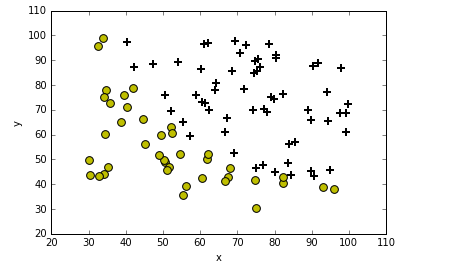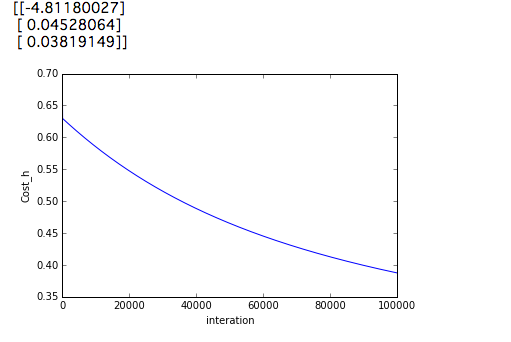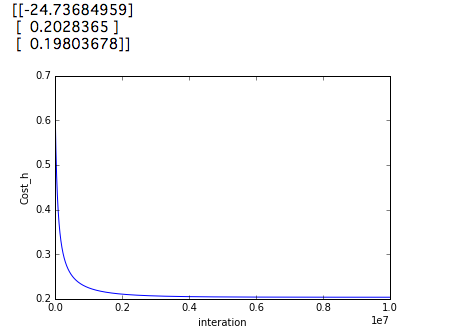I implemented Cousera's logistic regression in Python
Cousera --I implemented the logistic regression of Dr. Andrew Ng's Machine Learning Week3. I tried using only numpy as much as possible.
The customary magic.
%matplotlib inline
import numpy as np
import matplotlib.pyplot as plt
Read the data and plot it.
def plotData(data):
neg = data[:,2] == 0
pos = data[:,2] == 1
plt.scatter(data[pos][:,0], data[pos][:,1], marker='+', c='k', s=60, linewidth=2)
plt.scatter(data[neg][:,0], data[neg][:,1], c='y', s=60)
plt.xlabel('x')
plt.ylabel('y')
plt.legend(frameon= True, fancybox = True)
plt.show()
data = np.loadtxt('ex2data1.txt', delimiter=',')
plotData(data)
Next, implement the cost function and sigmoid function
Sigmoid function
Cost function
def sigmoid(z):
return(1 / (1 + np.exp(-z)))
def CostFunction(theta, X, y):
m = len(y)
h = sigmoid(X.dot(theta))
j = -1*(1/m)*(np.log(h).T.dot(y)+np.log(1-h).T.dot(1-y))
return j
Let's look at the first cost.
X = np.c_[np.ones((data.shape[0],1)), data[:,0:2]]
y = np.c_[data[:,2]]
initial_theta = np.zeros(X.shape[1])
cost = CostFunction(initial_theta, X, y)
print(cost)
The cost is like this. Next is the implementation of the steepest descent method.
def gradient_decent (theta, X, y, alpha = 0.001, num_iters = 100000):
m = len(y)
history = np.zeros(num_iters)
for inter in np.arange(num_iters):
h = sigmoid(X.dot(theta))
theta = theta - alpha *(1/m)*(X.T.dot(h-y))
history[inter] = CostFunction(theta,X,y)
return(theta, history)
initial_theta = np.zeros(X.shape[1])
theta = initial_theta.reshape(-1,1)
cost = CostFunction(initial_theta,X,y)
theta, Cost_h= gradient_decent(theta, X, y)
print(theta)
plt.plot(Cost_h)
plt.ylabel('Cost_h')
plt.xlabel('interation')
plt.show()
The result of executing it is as follows.
For some reason I get better results than setting num_iters to 10000000. Let's see the result.
def predict(theta, X, threshold = 0.5):
p = sigmoid(X.dot(theta)) >= threshold
return(p.astype('int'))
p = predict(theta,X)
y = y.astype('int')
accuracy_cnt = 0
for i in range(len(y)):
if p[i,0] == y[i,0]:
accuracy_cnt +=1
print(accuracy_cnt/len(y) * 100)
Running the above code will give you 91.0%. So what if you run num_inter at 1000000? ..
If you check this accuracy, it will be 89.0%. It is unclear why the above results are worse, despite the lower costs.
reference
https://github.com/JWarmenhoven/Coursera-Machine-Learning
Recommended Posts



